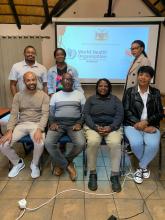Tackling Neglected Tropical Diseases: Mapping T. solium Taeniasis in Northern Namibia
During July and August this year, the Ministry of Health, and Social Services (MoHSS) with technical support from the World Health Organization (WHO) conducted a community based cross-sectional Taenia Solium taeniasis mapping survey. The survey was funded by GIZ through the Expanded Special Project for the Elimination of Neglected Tropical Disease (ESPEN). The mapping survey was conducted in five northern regions namely Kavango West, Ohangwena, Omusati, Oshana and Oshikoto. The identified regions share common risk factors for T. solium, including the presence of roaming pigs and inadequate sanitation.
Taeniasis is an intestinal infection caused by 3 species of tapeworm: Taenia solium (pork tapeworm), Taenia saginata (beef tapeworm) and Taenia asiatica. The parasite T. solium causes taeniasis and cysticercosis in humans. Cysticercosis is an infection of both humans and pigs with the larval stages of the parasitic cestode of Taenia solium. It is a zoonotic disease which is included in the list of the WHO Neglected Tropical Diseases. The life cycle of the parasite includes humans and pigs. Human cysticercosis can result in devastating effects on human health. Therefore, the focus of this survey was on T. solium taeniasis.
Infection with the T. solium tapeworm occurs when a person eats raw or undercooked infected pork containing the larval stages of the parasite (cysts). Infection with the tapeworm causes a few clinical symptoms; abdominal pain, loss of appetite, weight loss, and upset stomach. If a person ingests T. solium eggs (usually via the fecal oral route or contaminated food), then they develop cysticercosis. If the infection affects the brain, then it causes neurological symptoms such as severe headache, blindness, convulsions, and epileptic seizures, and can be fatal.
The overall goal of this survey was to determine the endemicity of T. solium in the areas identified as high and moderate risk using the WHO risk classification tool and to identify villages and regions where taeniasis and schistosomiasis co-exist to ensure safe implementation of Mass Chemotherapy/ deworming campaigns.
The field team members were nominated by their respective regions to implement the fieldwork within the target regions, completed a five-day training prior to the commencement of data collection. Overall, about 70 field team members participated in the training and they consisted of team 15 supervisors and supportive staff, 20 nurses, 10 community health workers, 16 drivers and 11 laboratory staff.
The training covered information on the introduction of Neglected tropical diseases (NTDs) in Namibia, the epidemiology of taeniasis, the survey protocol, data collection forms, electronic data collection tools, ethics, and a practical session in the field. The training also covered laboratory diagnostic techniques for sample processing. Each survey team was composed of two registered/enrolled nurses and a community health worker (CHW).
The target sample size for the selected regions was 960 per sampling unit/region, therefore, a total sample size of 4,800 was required of individuals aged 5 years and above. The field teams collected individual and household-level data including demographic information, physical observation of WASH facilities, taeniasis risk factor assessment, and samples of stool and urine for taeniasis from the randomly selected households.
The survey was successfully conducted during a period of five weeks, and the target sample size of 4,893 was reached. The outcome of the survey will determine if there is a need for public health intervention in the five regions to prevent the spread of taeniasis in communities and influence the planning and implementation of the mass deworming campaigns. The findings will also require strengthening of the engagement of other stakeholders in the implementation of the NTD interventions.


